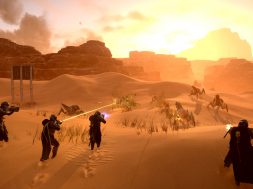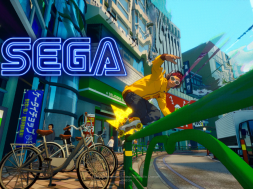
“What if someone made a First Person Shooter, combined it with a Platformer, filled each level with Puzzle elements and finally gave the player a special gun that changes the behavior of the environment?”
This is the beast that 5-Bit Games have decided to tackle with DeadCore.
I know that most of you are probably thinking “You just said fifty words and thirty-five of them were describing Portal”, but let’s clear up that misconception right off the bat. DeadCore certainly shares similarities with Valve’s beloved Portal, but once you scratch the surface it becomes a very different game indeed. DeadCore knows it isn’t Portal, but it also knows that it will be compared to Portal for combining the aforementioned gaming elements. In realizing this, it does its utmost to set itself apart and it manages this incredibly well within the first 10 minutes.
DeadCore opens by dropping you on a platform with nothing but some pretty scenery. No introductory FMV, no exposition and no other method whatsoever of telling you what exactly is happening and why you’ve arrived here. It just sets you down at the start of a path and expects you to follow.  This is the first way in which DeadCore separates itself from Portal and its many sub-par imitators. It doesn’t try to make its own version of a guide by mimicking GLaDOS or Wheatley with some snarky 343-GuiltySpark rip-off. Instead it opts for a much more integrated, if not subtle, method of teaching the player. Each ‘tutorial’ tip is added to the game in large floating letters that fade and change while you watch them. These pop up all the way through the game, at first teaching the basic controls and giving some direction, and later giving much more cryptic tips about upcoming challenges. It’s a great little feature and something that many bigger games should take note of for their tutorial levels. No one wants to be totally jarred from the experience by stopping to go through pages of text every few minutes.
This is the first way in which DeadCore separates itself from Portal and its many sub-par imitators. It doesn’t try to make its own version of a guide by mimicking GLaDOS or Wheatley with some snarky 343-GuiltySpark rip-off. Instead it opts for a much more integrated, if not subtle, method of teaching the player. Each ‘tutorial’ tip is added to the game in large floating letters that fade and change while you watch them. These pop up all the way through the game, at first teaching the basic controls and giving some direction, and later giving much more cryptic tips about upcoming challenges. It’s a great little feature and something that many bigger games should take note of for their tutorial levels. No one wants to be totally jarred from the experience by stopping to go through pages of text every few minutes.
The first panel tells us to “Climb the Tower” and this is as much of an explanation as we’re directly given throughout. Following this, we move slowly upwards, gently floating from ledge to hovering platform. Again this evokes memories of the first few rooms in Portal, before we’ve been given the Portal Gun, where the only choice is to carefully jump from portal to portal.  Once again, DeadCore changes the mix. After a few short sections of being lulled into false security, DeadCore ramps up the speed, barely giving you a resting moment between each threat and obstacle. This is the second major difference between Portal and DeadCore, and perhaps the most important in defining DeadCore as its own game. This is because the high speed platforming is ever present from here on out. While Portal rewards careful planning, patience and thinking your way through each stage, DeadCore favours the bold. You need to be constantly thinking 3 steps ahead, examining each element of the environment as you rush towards it and considering how to use it to your advantage. This brings a little bit of Unreal Tournament flavor to the game as you jump and dash to dodge oncoming lasers, hostile robots and other crushing environmental elements.
Once again, DeadCore changes the mix. After a few short sections of being lulled into false security, DeadCore ramps up the speed, barely giving you a resting moment between each threat and obstacle. This is the second major difference between Portal and DeadCore, and perhaps the most important in defining DeadCore as its own game. This is because the high speed platforming is ever present from here on out. While Portal rewards careful planning, patience and thinking your way through each stage, DeadCore favours the bold. You need to be constantly thinking 3 steps ahead, examining each element of the environment as you rush towards it and considering how to use it to your advantage. This brings a little bit of Unreal Tournament flavor to the game as you jump and dash to dodge oncoming lasers, hostile robots and other crushing environmental elements.
The final thing that DeadCore has in common with Portal is a weapon with special behavior. In Portal it was the titular Portal Gun, in DeadCore it’s the Switch Gun, whose name positively oozes with originality. Deadcore’s Switch Gun does as it’s name suggests, you shoot things with it and their behavior switches.  This switching can be applied to something as simple as opening a door, or turning off an enemy for a few seconds, to much more complicated features such as altering the gravity or completely changing the landscape of a level. All these effects last for only a few moments, so once again the race is on to reach the destination before everything switches back, leaving your path blocked, or worse, leaving you standing in midair with nothing to save you from a fall into the abyss below. Another little feature of the Switch Gun is that it gives a constant read out of your playtime. Starting from the instant you load and continuing until the final level is done. It adds another little layer to the feeling of being against the clock at all times, but is also a useful tool. By careful use of the gun’s clock, you can time events, finding out how long each one lasts so that, should you fail, you’ll have a better idea of when to use the Switch Gun next time around.
This switching can be applied to something as simple as opening a door, or turning off an enemy for a few seconds, to much more complicated features such as altering the gravity or completely changing the landscape of a level. All these effects last for only a few moments, so once again the race is on to reach the destination before everything switches back, leaving your path blocked, or worse, leaving you standing in midair with nothing to save you from a fall into the abyss below. Another little feature of the Switch Gun is that it gives a constant read out of your playtime. Starting from the instant you load and continuing until the final level is done. It adds another little layer to the feeling of being against the clock at all times, but is also a useful tool. By careful use of the gun’s clock, you can time events, finding out how long each one lasts so that, should you fail, you’ll have a better idea of when to use the Switch Gun next time around.
Another sign of DeadCore’s great self-awareness is that it knows you are going to die. It knows you are going to die a lot. For this reason each level is laden with checkpoints. These are usually placed right at the end of, or start of, a complicated challenge to make sure you don’t need to traverse a few tedious sections over and over again just to re-attempt a puzzle. The respawn times are also negligible; if you die you’ll be back at the checkpoint in an instant. DeadCore wants you to be constantly on the run, never stopping or slowing down to shatter immersion or consider taking a break from the adrenaline rush.  There are a few distinct points where you’ll just be constantly pushing forward, jumping or sharpshooting as you go, then dying and trying again all without taking your finger off the move key.
There are a few distinct points where you’ll just be constantly pushing forward, jumping or sharpshooting as you go, then dying and trying again all without taking your finger off the move key.
While DeadCore is deserving of high praise, there are a few imperfections, though these are easily forgiven, especially given that it started life as a low budget Indie game. First of all, the game is quite short, with roughly 4 hours of play time for a single run through and maybe 6 in total if you wish to find every hidden pickup, lore page and music track. This is another thing it has in common with Portal, a great experience over too soon, but while it lasts it is golden. The second bone to pick is with the game’s soundtrack. It’s bland and so beige that I barely noticed it at all as I played through it. It has some neat little sound effects, true, but the score is weak. This little point was easily remedied by throwing a Daft Punk playlist on in the background, one packed with plenty of tracks from the Tron Legacy soundtrack. This fitted in really well actually, given the game’s gorgeous style and visuals.
The final gripe is something less forgivable, especially given how neatly the game ties in the aforementioned shifting word tutorials. The lore is awfully presented. To read each page you’ll need to trawl through a few menus, and even then you’re greeted by a grey, sullen textbox. It feels as though the game was never meant to have a storyline or any sort of fluff, and that would have been fine. The game may have actually been improved by setting the simple task of “Climb to the top of The Tower” and forgetting the lore pages, just living its life as a puzzle game. These just come off as a thoroughly uninspired afterthought and the menu is so devoid of style that it becomes totally jarring. It is so totally counterintuitive that the very items meant to bring more immersion to the world end up breaking it the most. Even stranger is that the other game menus continue to borrow from the game’s Tron-inspired style, but this big, ugly grey box it just slapped on top if you want to read a little more.
To read each page you’ll need to trawl through a few menus, and even then you’re greeted by a grey, sullen textbox. It feels as though the game was never meant to have a storyline or any sort of fluff, and that would have been fine. The game may have actually been improved by setting the simple task of “Climb to the top of The Tower” and forgetting the lore pages, just living its life as a puzzle game. These just come off as a thoroughly uninspired afterthought and the menu is so devoid of style that it becomes totally jarring. It is so totally counterintuitive that the very items meant to bring more immersion to the world end up breaking it the most. Even stranger is that the other game menus continue to borrow from the game’s Tron-inspired style, but this big, ugly grey box it just slapped on top if you want to read a little more.
When all is said and done, DeadCore is still a gem of a game, and at only €7 you would be doing yourself a disservice not to pick it up if you enjoy platformers or puzzle games. The gameplay is solid, the visuals are amazing and every single bit of the game is absolutely dripping with style.
Solid gameplay, ace visuals, drips with style! 7/10









